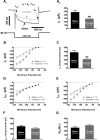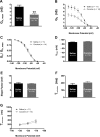Cocaine sensitization inhibits the hyperpolarization-activated cation current Ih and reduces cell size in dopamine neurons of the ventral tegmental area
- PMID: 22262829
- PMCID: PMC3331609
- DOI: 10.1152/jn.00818.2011
Cocaine sensitization inhibits the hyperpolarization-activated cation current Ih and reduces cell size in dopamine neurons of the ventral tegmental area
Abstract
The progressive augmentation of motor activity that results from repeated cocaine administration is termed behavioral sensitization. This phenomenon is thought to be a critical component in compulsive drug taking and relapse. Still, the cellular mechanisms that underlie sensitization remain elusive. Cocaine abuse, nonetheless, is known to evoke neuroplastic adaptations in dopamine (DA) neurotransmission originating from the midbrain's ventral tegmental area (VTA). Here, we report that concomitant with the development of locomotor sensitization to cocaine the hyperpolarization-activated cation current (I(h)) amplitude is depressed by ∼40% in VTA DA cells. Such effect did not result from a negative shift in I(h) voltage dependence. Nonstationary fluctuation analysis indicates that this inhibition was caused by an ∼45% reduction in the number of h-channels with no change in their unitary properties. The cocaine-induced I(h) depression was accompanied by a reduction in cell capacitance of similar magnitude (∼33%), leaving h-current density unaltered. Two implications follow from these data. First, I(h) inhibition may contribute to cocaine addiction by increasing bursting probability in DA cells and this effect could be intensified by the decrease in cell capacitance. Second, the cocaine-induced diminution of DA cell capacitance may also lead to reward tolerance promoting drug-seeking behaviors.
Figures






References
-
- Alvarez O, Gonzalez C, Latorre R. Counting channels: a tutorial guide on ion channel fluctuation analysis. Adv Physiol Educ 26: 327–341, 2002 - PubMed
Publication types
MeSH terms
Substances
Grants and funding
LinkOut - more resources
Full Text Sources

